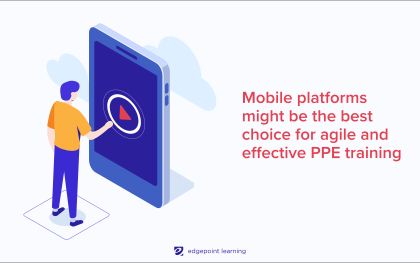How To Roll Out PPE Training To Your Employees
Corey Bleich
🍿 5 min. read
PPE training can save lives. Here's how to roll it out to everyone who needs it.
It may seem like hyperbole to say that training can save your employees’ lives, but when it comes to PPE training, it’s no exaggeration. Here is how to roll out PPE training to everyone who needs it.
What is PPE training?
PPE training covers the proper use of personal protective equipment that guards the health and safety of employees. It lays out the standards for proper use and helps keep employees (and the people they serve) safe.
A typical PPE training course often covers the following topics:
- When PPE is necessary (and when it won't help)
- What types of personal protective equipment is available for employees
- The proper way put on, adjust, wear, and take PPE off
- The proper care, maintenance, and disposal of equipment
- How long personal protective equipment is effective
- How to inspect equipment for damage or wear
As an example of its importance, first responders who do not know how to properly use PPE could be compromised if they fall sick or become injured in the line of duty. Workers who use PPE are also protecting those around them from illness and accidental injury. If caregivers, first responders, and other healthcare workers carry illness, PPE helps prevent the spread of that to others.
PPE training is critical for employees and those they serve
What types of PPE should I cover in our training?
Think of it this way: if the work requires personal protective equipment, then correct and detailed PPE training is also required. There are five types of PP that training typically covers:
- Head protection
- Eye and face protection
- Clothing
- Hand protection
- Footwear
Let's look at all of these in more detail.

1. Head protection
Head protection helps prevent head injuries from blows, shock, fire, or any other injury that could damage the skull. Head protection is required at most construction sites and is a critical part of equipment for firefighters as well.
Any occupation that is at risk of injury due to falling objects should use head protection.
2. Eye and face protection
Eye and face protection can include:
- Face shields or masks
- Safety goggles
- Ear protection
For welders, PPE protects the eyes from damage to the internal structures as well the face itself. Healthcare workers use PPE to protect themselves from airborne particulate matter as well as injury to the face. Workers in loud facilities will need to protect their hearing with ear buds or larger noise-cancelling headphones.
In all occupations, eye and face equipment protect against hazardous liquids that splash and airborne particulates. For proper impact protection, your employees might also use a combination of PPE (e.g., googles or safety glasses along with face shields).
3. Clothing
Proper clothing protects the body and vital organs from injury or damage during the workday. Body protection also guards against extreme temperatures and potential impacts.
Depending on what your employees do, your training might include something as simple as selecting the proper scrubs to use during rounds, or it may cover how to use level-4 hazmat suits when cleaning up chemical spills.
4. Hand and arm protection
Gloves, finger guards, and elbow-length arm coverings are all a part of PPE training in hand and arm protection. Employees that work with chemicals, come into contact with infectious or contagious disease, or those who work with specialized machinery may all need hand and arm protection to stay safe on the job.
Everyone from nurses to lab technicians to welders need to know how to properly utilize this type of protection, when its required, and how to maintain this equipment.
5. Footwear
PPE training for footwear consists of outlining the reasons for protective footwear and the proper use and care of shoes and other protective equipment.
Proper footwear not only offers protection from slipping. It also can prevent shock from electrical hazards. For occupations that work around molten liquids, proper footwear protects against serious burns. Those who work in healthcare environments may wear protective booties to prevent the spread of disease.
Footwear training may also include which types of socks or leggings to wear underneath shoes, as well as foot or shin guards.
How to design PPE training
Designing a PPE training follows a few simple steps. From the beginning, you need to decide which employees need which type of training and who needs it the most quickly. A training assessment can help you figure out your needs and prioritize them quickly. Read our post here for a detailed overview of this process.
Next, consider the best training approach. When all hands are on deck, pulling them back from work to sit in a conference room all day for training is not the best move. There are a variety of training platforms you can use that deliver just-in-time, on-the-job training that protects your employees when and where they need it most.
Microlearning in the flow of work means information is accessible when it’s needed most. This could be something as simple as a push notification to employee phones that updates the status of an emergency, or it may be an alert for employees to don certain kinds of PPE when they enter a geofenced location. It could also be a simple static resource that they can refer to when needed, such as care and maintenance guides.
Mobile platforms might be the best choice for agile and effective PPE training.

Build your PPE training program
Trying to design PPE training that considers actual working conditions and what employees need? The experts might just be employees themselves. Design training that has room for employees in the field to contribute.
From there, if you need an additional set of hands for development or want to consult with experts in mobile-first training development, EdgePoint can help. You can choose and customize from our pre-built mobile PPE training aids. Need PPE training built from the ground up? Our team can be the extra set of hands you need to develop your training with our co-development services, or we can manage development from training assessment to final roll-out.
Get in touch today to see how EdgePoint can help with your PPE training.
